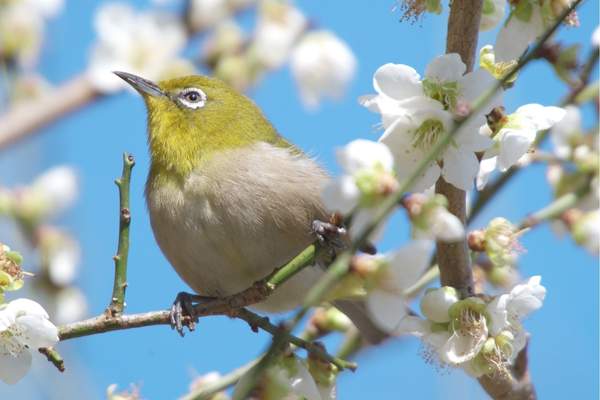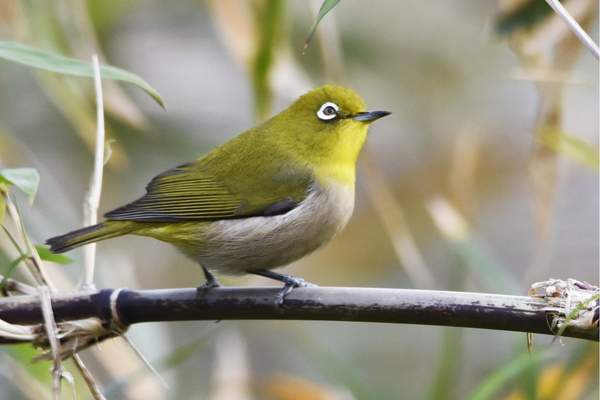Common Name: Japanese White-eye
Scientific Name: Zosterops japonicus| Size | Diet | Range in Hawaii | Status in Hawaii |
|---|---|---|---|
| 4 in. - 4.5 in. | nectar, fruits and a variety of insects | Big Islands | least concern |
The Japanese white-eye (Zosterops japonicus) is a small, brightly colored songbird that is native to Japan, Taiwan, and some parts of Southeast Asia. It is a member of the white-eye family, which includes more than 50 species of small birds found throughout the tropical and subtropical regions of the world.
Japanese White-eye

Appearance
Japanese white-eyes are known for their distinctive appearance, which includes a bright green back, wings, and tail, and a yellow breast and belly. They also have a small, white ring around their eyes, which gives them their common name.
Diet
Japanese white-eyes are omnivorous, and their diet consists of a variety of insects, nectar, and fruit. They are also known to feed on small spiders and worms.
Behavior
These birds are social animals and are often seen in small flocks, although they are known to be territorial and will defend their territory against intruders. Japanese white-eyes are known to be vocal birds, and they communicate using a variety of high-pitched, chirping sounds. These sounds are used to communicate with other members of the flock, to attract a mate, and to defend their territory.
Nesting
Japanese white-eyes are known to be good nest builders, and they often build their nests in the branches of trees or shrubs. These nests are usually made of grass, moss, and other plant materials, and are lined with softer materials such as feathers or fur.
Japanese white-eyes are known to lay clutches of 2-5 eggs, which are incubated by both the male and female. The eggs are typically white or pale blue in color and are about 0.7 inches (18 mm) long. Incubation takes about 12-14 days, and both parents help to incubate the eggs and care for the chicks.
The chicks are altricial, meaning that they are born naked and helpless, and require significant care from their parents. The chicks are fed by both parents, and they fledge (leave the nest) at about 14-17 days of age.
Habitat

Japanese white-eyes are known to inhabit a variety of forest types, including deciduous, coniferous, and mixed forests. They are also found in gardens, parks, and other urban areas. These birds are known to be adaptable and are able to thrive in a variety of environments.
Range
Japanese White-eyes have been introduced to several locations around the world, including Hawaii, where they are a common and widespread species. In Hawaii, Japanese White-eyes can be found on all of the main islands, and are a popular and well-known bird in the state.
Conservation Status
Japanese White-eyes are not considered to be a threatened or endangered species, and they have a stable population in their native range of East Asia, including Japan, China, and Taiwan. They are classified as a species of “Least Concern” by the International Union for Conservation of Nature (IUCN).
Interesting Facts
1. They are active and energetic
These birds are known to be active and energetic, and they are often seen flitting from branch to branch in search of food.
2. They are good swimmers
Japanese white-eyes are known to be good swimmers and are often seen bathing in puddles and other small bodies of water.
3. They are monogamous
Japanese white-eyes are known to be monogamous, and they are known to form strong pair bonds with their mates.
4. They are popular
They are popular as aviary birds and are often kept by birdwatchers and hobbyists.
Frequently Asked Questions
What is the size of a Japanese white-eye?
Japanese white-eyes are small birds, with an average length of about 4 inches (10 cm). They have a bright green back, wings, and tail, and a yellow breast and belly.
Where did the Japanese white-eyes name come from?
The Japanese white-eye gets its name from its distinctive white ring around the eye, which is a characteristic feature of the species. In Japanese, the bird is known as the “mejiro,” which means “round eye.”
How long do Japanese white-eyes live?
Japanese white-eyes typically live for about 5-7 years in the wild. In captivity, they can live longer, up to about 10 years.




